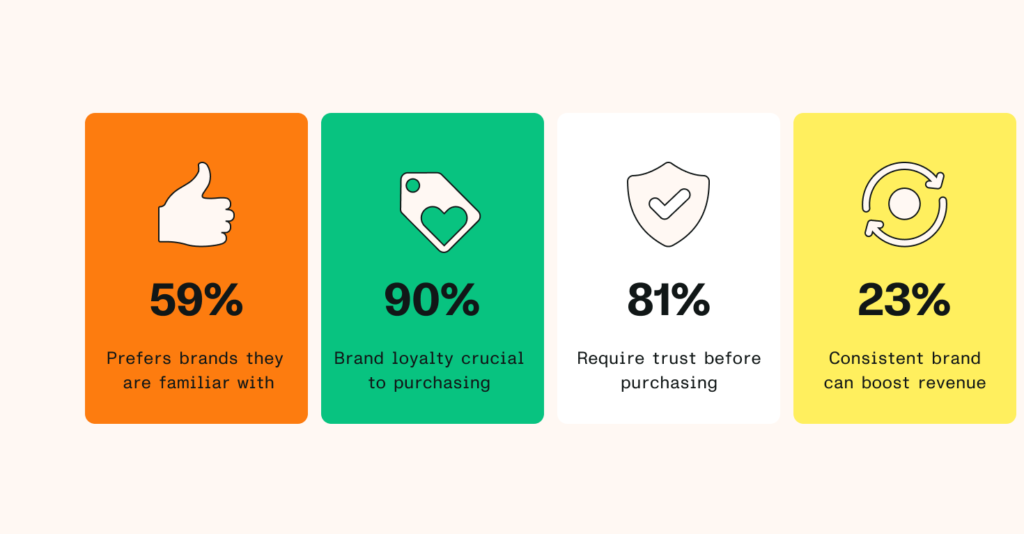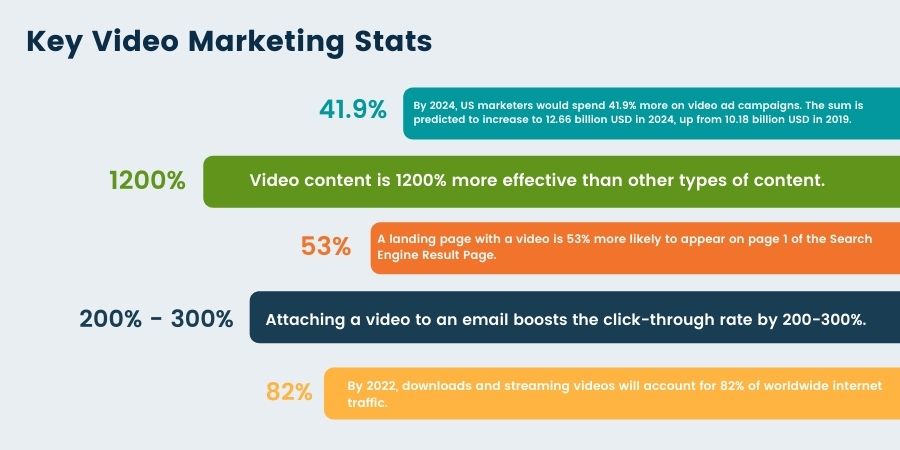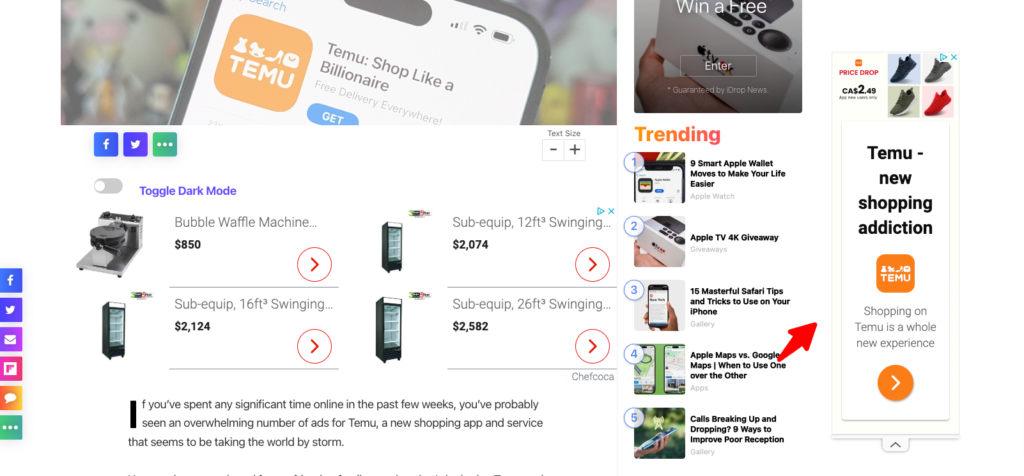
In the dynamic world of global business, small and medium-sized enterprises (SMEs) are stepping onto the international stage with unbridled ambition and unwavering determination.
As these aspiring global leaders seek to leave an indelible mark beyond local borders, the key to success lies in well-crafted international digital marketing strategies.
This post provides simple digital marketing global strategies to help elevate your SME beyond local borders.
Table of contents
- Unlocking Opportunities for SMEs in the Digital Global Economy
- How to Create an International Digital Marketing Strategy
- Check Your Online Presence and Understand Your Market
- Unlock the Power of Branding: A Key to Global Marketing Strategy
- Set S.M.A.R.T. Goals
- Develop a Buyer Persona
- Develop a Content Plan and Tactics
- Develop Regional Email Marketing
- Utilize International SEO
- Connect to Your Global Audience with Social Media
- Customized Digital Advertising
- Conclusion
- Frequently Asked Questions
Unlocking Opportunities for SMEs in the Digital Global Economy
The digital economy accounted for 53.3 trillion U.S. dollars in 2023, more than half of the overall nominal GDP.
Source: Statista
Moreover, digital technology is expected to drive more than two-thirds of productivity growth and account for 25 percent of global GDP by 2030.
To succeed in the digital global economy, SMEs need to adopt international digital marketing strategies that can help them leverage data-driven digital platforms, optimize their online presence, and tailor their products and services to the needs and preferences of different markets and cultures.
By doing so, SMEs can duplicate their success in one country to another country and benefit from the digital transformation.
How to Create an International Digital Marketing Strategy
Here’s how to unlock the best digital marketing global strategies for your business:
Check Your Online Presence and Understand Your Market
Examining your online presence is a crucial step when venturing into the global digital market. This meticulous analysis can illuminate areas that require refinement and improvement. It’s a process that not only enhances your existing assets but also paves the way for a more successful international digital marketing strategy. To underscore the importance of this step, let’s consider a less widely known example of a failed global marketing strategy:
In the early 2000s, a small European clothing brand, “FashionFusion,” embarked on a global expansion journey. They decided to enter the U.S. market, targeting American consumers with their unique blend of European styles. However, they overlooked the critical step of auditing their online presence and understanding the market they were entering.

Upon launching in the U.S., they faced several issues. Firstly, their website lacked localization, making it challenging for American consumers to navigate and make purchases. Additionally, FashionFusion’s social media content didn’t resonate with U.S. audiences, as it predominantly featured European fashion trends and cultural references.
The failure to adapt their online presence to the specific needs and preferences of American consumers resulted in poor market reception. The brand struggled to gain traction, leading to disappointing sales and a tarnished reputation. Ultimately, FashionFusion’s lack of attention to its online presence and the failure to grasp the nuances of the U.S. market proved detrimental to its global expansion ambitions.
To avoid such pitfalls, conducting a comprehensive audit of your website, social media accounts, and digital platforms is crucial. This process helps identify areas in need of improvement, such as localization, content adaptation, and user experience optimization. Simultaneously, gaining a deep understanding of the target market’s cultural nuances, preferences, and trends is paramount. By learning from past examples like FashionFusion, businesses can ensure that their online presence aligns seamlessly with their global marketing objectives, setting the stage for international success.
Unlock the Power of Branding: A Key to Global Marketing Strategy
Regardless of the size of a company or how long it has been in operation, branding plays a crucial role, particularly for those entering the global market. Sadly, numerous entrepreneurs become so focused on marketing their goods or services that they fail to see the fundamental significance of branding. Since branding is a strategy meant for the long haul and might not deliver instant outcomes, some proprietors might view it as an unnecessary expenditure of time and resources. Nevertheless, it’s vital to understand that strong branding is the foundation of lasting sales achievement. As we delve into the intricacies of creating a winning digital marketing strategy for the global market, it’s crucial to emphasize not just the ‘how’ but also the ‘why’ behind branding, especially for small and medium-sized enterprises (SMEs) aiming for international success.
The statistics provided offer a clear insight into the current landscape of branding and its pivotal role in driving sales, loyalty, and overall business growth. Through the lens of provided statistics, we gain invaluable insights into the prevailing dynamics of branding and its critical influence on augmenting sales, fostering loyalty, and catalyzing comprehensive business growth.
Consumer Preferences and Brand Loyalty
Bridging this understanding of branding’s foundational role in the realm of consumer behaviour unveils the profound impact of brand familiarity and loyalty.
- Most people, around 59%, like to buy new things from brands they already know. Apple’s loyal customer base and their anticipation for new releases underscore the significance of brand recognition.
- 90% of customers said that sticking with a certain brand is really important when they decide what to buy. Amazon Prime leverages to enhance customer retention and encourage repeat purchases through its loyalty program.
Trust, Consistency, and Strategic Investment
Trust, consistency, and strategic investment in branding further crystallize as key pillars.
- The majority of shoppers, specifically 81%, need to believe in a brand before they buy from it—a principle demonstrated by Patagonia through its commitment to transparency and ethical practices.
- Keeping your brand’s look the same everywhere can increase profits by up to 23%—a fact proven by the timeless branding of Coca-Cola.

Source: Linearity
What this means is that in the business world, having a popular brand is not just a nice extra; it’s a big deal that affects what people buy and can make companies more money. However, just being famous isn’t sufficient. Customers who stick with a brand tend to come back, highlighting how important it is for businesses to build these connections and make sure customers are happy.
Set S.M.A.R.T. Goals
To navigate this complex landscape, setting S.M.A.R.T. goals is essential. They provide clarity and direction, ensuring that every aspect of your digital marketing strategy is carefully considered and appropriately targeted. These goals should be:
Regularly Set Goals for Entering New Markets in New Ways
Even if you sell goods throughout the world in an online-only store, you will still need to deal with a host of other factors, such as regional and national marketing, distribution, legal compliance, and currency conversions. Because of this, you cannot consider a market to be penetrated simply because people in that market have access to your goods. Evaluate market penetration goals in terms of building brand awareness and reaching your market-share goals in different areas of the world.

Address Financial Needs and Capital Sources
Global growth strategies are often high-cost propositions that must be financed with debt, venture capital, or even a switch to a corporate structure to sell stock. No international expansion plan is complete without addressing the financial requirements of growth strategies, and the potential sources of capital. Growth-strategy costs can be challenging to estimate but try to use exact figures as often as possible. You can use exact figures from advertising agency quotes when budgeting for international marketing, for example, but distribution costs can be more difficult to estimate due to their dependence on demand.
Set Strategic Partnerships
Determine the kinds of strategic partnerships you would like to form in different regions or markets, and set goals for building and cultivating these relationships over time. You might set a goal of establishing at least one local supplier in each region you do business in, for example, or of finding the highest value customer-support partner outside of your home country. You might also set a goal of forming relationships with local marketing contractors in different parts of the world, and tie them into regional sales goals to keep the relationships productive. Consider foreign acquisitions as another way to penetrate international markets effectively.
Tailor Market Share Goals
Your goals should be related to your competitive position in each market that you serve around the world. Use different goals for each market, considering consumer preferences in each region. You might set a goal of being the first or second largest player in your home country, for example, while shooting for the top 10 or 20 in distant markets with strong domestic competitors.
Set goals for market share on a global scale based on your different regional goals. Add global competitors to the equation, and lump regional and local competitors into a single category when considering the global distribution of market share.
Setting Timely Goals for Successful Global Expansion
All of your goals for global competitiveness should be tied to achievable time frames to keep your expansion plans on track. Always have a time frame in mind when setting goals, and be aware of potential circumstances that can derail your timeline. Set time-bound goals related to actors that can propel you forward in your global expansion plans, such as revenue growth, profitability, and workforce growth. For example, set goals for the number of new outlets to open each quarter or the number of new markets to advertise in each year.
Use the Critical Path Method to map out the total timeline of your long-term plans. Understanding the critical path in your growth strategy can help you to focus on the most time-sensitive elements. By integrating these S.M.A.R.T. objectives into your digital marketing strategy appropriately, you’ll be better positioned to not only boost sales but also to establish a trustworthy brand presence internationally. This dual focus will help you stand out in a competitive global market and foster the trust of customers around the world, which is essential for sustained international growth.
Develop a Buyer Persona
A one-size-fits-all approach doesn’t cut it. Creating detailed buyer personas helps SMEs understand their diverse audience segments. According to research from ITSMA, by defining their buyer personas, brands can increase their lead acquisition by 24% while increasing their lead quality by over 56%.
Source: Delve AI
Imagine a retail business looking to expand its operations either across European countries or into the United States. Through meticulous research and the development of detailed buyer personas, they gain a profound understanding of their diverse target market. Their efforts pay off significantly, with research indicating that by crafting these buyer personas, the company experiences a substantial 24% increase in lead acquisition, along with an impressive 56% improvement in lead quality.
For example, if they are targeting European countries, their buyer persona research reveals distinct preferences and behaviours. In Germany, consumers highly value product quality and efficiency, while in France, they prioritize style and aesthetics. Meanwhile, Scandinavian countries emphasize sustainability and eco-friendliness in their purchasing decisions.
Alternatively, if they are entering the U.S. market, their buyer personas show that customers in the Northeastern states may be more inclined toward fashion-forward and trendsetting products, whereas customers in the Midwest may prioritize affordability and durability.
To maximize the impact of these buyer personas, the retail business aligns its marketing strategies with the different stages of the sales funnel. This ensures that their communication remains tailored and effective at every touchpoint, whether it’s raising awareness, driving consideration, or closing sales. By doing so, they establish a strong presence in their target regions and foster customer loyalty, driving their expansion efforts in Europe or the USA.
Develop a Content Plan and Tactics
A well-crafted content plan is the linchpin of successful international digital marketing strategies. Employ varied content strategies, including blogs, infographics, videos, and more, to engage a global audience. Localize content where necessary, ensuring cultural relevance and resonance.
According to a study by Semrush, most businesses saw a 53% increase in their overall engagement by finetuning their content strategies, with 49% of them seeing an increase in traffic. This means developing a content plan should be a key priority when you want to build a digital marketing strategy for global businesses.
Source: Semrush
No longer constrained by geographical boundaries, SMEs, especially those in Canada, find themselves equipped with a powerful ally — the Canada Digital Adoption Program (CDAP). This transformative initiative not only empowers SMEs but also levels the playing field, providing essential funds for the implementation of digital marketing global strategies.
Finding the right CDAP digital advisor, such as Noah Digital, to assist from the planning to the implementation of these marketing strategies for small businesses, can transform the trajectory of your brand on a global scale.
By embracing effective marketing tactics, fueled by the support from funds like the CDAP Stream 2, SMEs can not only dream of global triumph but turn those dreams into a tangible reality.
Tailor Your Copy for Specific Regions
Create valuable and relevant copy that addresses the pain points and interests of your global audience. This is because you need to focus more on building brand authority and trust. The paradigm shift from a sales-centric approach to a holistic branding and marketing strategy opens doors for SMEs to compete on a level playing ground with industry giants.
Create a Connection with Your Audience with Video
Video marketing is one of the best digital marketing trends to consider. Leverage the power of visual storytelling to convey your brand message. Here’s how you can effectively harness the power of video for international appeal, along with an example from well-known brands:

Source: Buzzflick
Visual Storytelling: Video allows you to tell compelling stories that resonate with viewers on an emotional level. Craft narratives that transcend language and cultural barriers, focusing on universal themes like human connection, shared experiences, and aspirations. For instance, Coca-Cola’s “Share a Coke” campaign achieved global success by emphasizing the simple joy of sharing a drink with a friend, a concept universally understood and cherished.
Language Adaptation: To bridge language barriers, consider incorporating subtitles or providing multiple language options in your videos. This ensures that viewers from different regions can fully engage with your content. Nike, for example, often releases videos with subtitles or voiceovers in various languages to cater to their global audience.
Cultural Sensitivity: When creating videos for international audiences, be aware of cultural nuances and avoid content that may be perceived as insensitive or inappropriate. Research and respect local customs, traditions, and sensitivities. An example of cultural sensitivity in action is Airbnb’s “We Accept” campaign, which featured hosts from various cultures and backgrounds, promoting inclusivity and respect.
Global Themes: Consider focusing on themes that have global relevance. Sustainable practices, social responsibility, and the pursuit of a better world are topics that resonate across borders. Patagonia’s “Don’t Buy This Jacket” video campaign is a prime example, aligning with global concerns about environmental conservation and responsible consumption.
Develop Regional Email Marketing
Email marketing is a valuable tool for businesses seeking to establish a global presence and connect with audiences worldwide. It enables you to deliver personalized and targeted messages directly to your subscribers, regardless of their location. To effectively utilize email marketing on a global scale, consider these strategies:
Segmentation: Segment your email list based on geographic regions or language preferences. For instance, if you’re an e-commerce company expanding into Europe and Asia, you can create separate email lists for European and Asian subscribers. This allows you to send region-specific content and promotions, increasing relevancy and engagement.
Localization: Tailor your email content to resonate with the cultural and linguistic diversity of your global audience. For example, if you’re a travel agency promoting international tours, you can send region-specific itineraries, travel tips, and local insights. Airbnb excels at this by sending personalized recommendations based on the traveller’s destination.
Timing: Take time zones into account when scheduling email campaigns. Sending emails at the right time ensures that your message lands in the recipient’s inbox when they are most likely to see it. Analyze your audience’s activity patterns and adjust send times accordingly.
Currency and Pricing: If your business involves transactions, display prices in the local currency and provide accurate conversion rates. Additionally, offer region-specific discounts or promotions, as Booking.com does by providing users with pricing in their local currency and reflecting local offers.
Regulatory Compliance: Be aware of international email regulations and data privacy laws, such as GDPR in Europe or CAN-SPAM in the United States. Ensure your email marketing practices align with these regulations to avoid legal complications.
Multilingual Support: If you have customer support services, provide multilingual assistance via email. Dropbox, for instance, offers customer support in various languages to cater to its global user base.
Utilize International SEO
When gearing up for global expansion, optimizing your website for local searches is paramount to resonate with diverse audiences across the world. Here are practical steps to enhance your website’s Search Engine Optimization (SEO) on a global scale, illustrated with examples:
Localized Content: Tailor your website content to suit specific regions and languages. Airbnb, for instance, offers localized versions of its site with language options and region-specific content, ensuring that users in different countries feel at home.
Keyword Research: Understand the search terms used by your international audience. Google’s Keyword Planner can help identify relevant keywords in various languages. Amazon, a global e-commerce giant, employs localized keywords to attract customers in different countries.
Cultural Sensitivity: Be mindful of cultural nuances. Coca-Cola’s “Share a Coke” campaign, which successfully expanded across cultures, maintained cultural sensitivity by respecting naming traditions in each region.
Multilingual Support: Offer multilingual support, including customer service and translation services if needed. Booking.com provides multilingual customer support to assist users in their preferred language, enhancing their global reach.
Local SEO: Optimize your website for local search engines. Baidu is a dominant search engine in China, and businesses targeting the Chinese market often invest in Baidu SEO to improve their visibility.
Geolocation and Currency: Implement geolocation features that automatically detect users’ locations and display content or prices in their local currency. Amazon, with its global reach, customizes its website based on users’ geographical location.
Analytics and Adaptation: Regularly analyze website traffic and user behaviour in different regions. Use tools like Google Analytics to track performance and adapt your strategy based on data insights.
Connect to Your Global Audience with Social Media
Engage with international audiences on platforms that resonate with them. Get stellar social media marketing & management services and curate content to suit the cultural norms and preferences of your global target audience.
Platform Selection: Different social media platforms are popular in various regions. Research and identify the platforms that resonate the most with your target audience in each country or region you’re targeting. For instance, while Facebook may be dominant in the United States, platforms like WeChat and Weibo are more influential in China.
Cultural Sensitivity: Cultural norms and preferences vary significantly from one region to another. Your content should respect these differences and avoid anything that could be considered offensive or insensitive. For example, humour that works in one culture might not translate well to another.
Language Localization: If you’re targeting non-English speaking markets, it’s essential to provide content in the local language. This includes not only written content but also video subtitles and graphics. Machine translations can lead to misunderstandings, so consider professional translation services.
Content Relevance: Tailor your content to be relevant to the specific needs and interests of your international audience. For example, if you’re a sports apparel brand expanding into Europe, your content might focus on football (soccer) for the European market, while in the U.S., it might emphasize American football or basketball.
Timing and Time Zones: Be mindful of time zones when scheduling posts and engaging with your audience. Posting at a time when your target audience is most active ensures better visibility and engagement.
Influencer Marketing: Influencer marketing has grown significantly, with the industry’s value expected to reach $22.2 billion by 2025. This global phenomenon is most prevalent in sectors like Fashion & Beauty, Gaming, and Health & Fitness, with a diverse geographical spread across continents. Instagram dominates as the preferred platform, housing over 500,000 influencers, mostly nano-influencers, with the highest engagement rates. The average cost for influencer collaborations varies, with Instagram influencers charging around $363 and user-generated content creators around $396 per collaboration. This marketing strategy continues to gain traction, reflecting its effectiveness in driving sales and brand awareness globally
To amplify your global reach, incorporate influencer marketing into your social media strategy. Influencers, with their large and dedicated followings, can significantly impact your brand’s visibility in different regions. Choose influencers who align with your brand values and have a substantial following in your target markets. Collaborating with local influencers not only increases credibility but also ensures that the content is culturally relevant and resonates with the local audience.
Source: Statista
Customized Digital Advertising
Digital advertising serves as a dynamic tool for businesses aiming to establish a global presence. A great example of a recent digital marketing globalization is TEMU, which entered the Canadian market by adapting its offerings to align with local consumer preferences and shopping habits. TEMU also capitalized on seasonal trends and local events in Canada, creating timely and relevant ads that appealed to the market’s current interests and needs. This strategic approach enabled TEMU to quickly establish itself as a competitive force in the Canadian e-commerce sector.

Let’s delve into the strategic use of paid advertising campaigns to target specific regions and fuel international expansion:
Geo-Targeting Precision: Leverage the geo-targeting capabilities of digital advertising platforms to pinpoint specific regions that align with your global expansion goals. Google Ads, for instance, allows you to target countries, regions, or even specific cities. If you’re an online retailer looking to expand into Europe, you can tailor your ads to reach users in the United Kingdom, Germany, and France, where you see the most potential.
Multilingual Ad Campaigns: Crafting ads in the local language of your target audience can significantly boost engagement. TripAdvisor successfully executes this strategy by running multilingual campaigns catering to travellers from around the world. Their ads adapt to the language preferences and travel interests of users in different regions, providing a personalized experience.
Localized Offers and Promotions: Tailor your ad content to cater to the specific needs and preferences of users in different regions. McDonald’s, a globally recognized brand, adjusts its promotions to suit local tastes and cultural events. For example, offering a McFlurry with exotic flavours in India during a festive season, appealing to local traditions.
Timing and Seasonality: Consider the timing and seasonality of your ad campaigns. If you’re in the fashion industry, launching ads for winter collections at the appropriate time is crucial. Zara, an international fashion retailer, excels at timing its ads to coincide with seasonal shifts in different parts of the world, effectively capturing consumer attention.
Cross-Border Remarketing: Implement cross-border remarketing campaigns to re-engage with users who have previously interacted with your website or products. Amazon employs this strategy seamlessly by retargeting users across regions with product recommendations based on their previous browsing and shopping behaviour.
Competitive Benchmarking: Keep an eye on your competitors’ international advertising strategies. For instance, Airbnb monitors competitors’ pricing and availability to ensure their ads remain competitive and appealing to travellers in diverse markets.
Localized Landing Pages: Create landing pages that resonate with the cultural preferences and expectations of users in different regions. Booking.com adapts its landing pages to highlight local accommodations, activities, and reviews, ensuring a personalized experience for users worldwide.
Localized Ad Extensions: Utilize ad extensions that provide users with region-specific information, such as store locations, phone numbers, or currency converters. Starbucks incorporates location extensions in their ads, allowing users to find nearby stores effortlessly, irrespective of their global location.
Conclusion
Venturing into the global market is an ambitious yet rewarding endeavour for businesses. The key to successful international expansion lies in a holistic approach encompassing various marketing facets, from website optimization and content localization to email marketing, SEO, and digital advertising. Businesses can establish a strong global presence by understanding the unique needs and preferences of different regions, maintaining cultural sensitivity, and harnessing the capabilities of digital tools. The examples of successful global marketing strategies from renowned brands serve as valuable inspirations for achieving international success. As businesses adapt, remain agile, and continue to prioritize their global audience’s satisfaction, they can navigate the complexities of international markets and thrive on a global scale.
Frequently Asked Questions
You can utilize key performance indicators (KPIs) such as website traffic, leads, sales, conversion rates, and social media engagement.
Common challenges include cultural differences, language barriers, and adapting to diverse market trends. You can overcome these challenges by conducting thorough market research, localizing content, leveraging technology for translation, and partnering with local experts or agencies.
Conduct market research to analyze demand, competition, and cultural fit. You should also consider demographics, economic conditions, and regulatory environments.
Branding establishes a company’s unique identity, builds trust and credibility, creates an emotional connection with consumers, communicates the value proposition, and strategically positions the company in the market.
Without a winning digital marketing strategy before going global, companies may face limited brand visibility, inefficient targeting of international audiences, misallocating resources, cultural missteps, lower customer engagement, and ultimately, reduced market share and revenue in global markets
Author's Bio
Dr. Bin Tang, founder and CEO of Noah Digital, is renowned for using AI to turbocharge online businesses and unlock search engine secrets. His innovative ‘7-Step Amplify Sales & Leads in a Year’ strategy and management of massive ad campaigns for Google and Bing have dramatically increased online visibility and sales.

